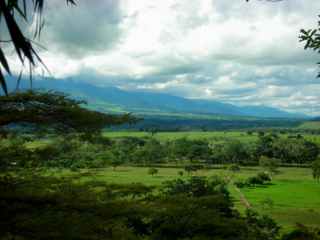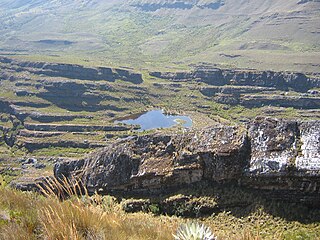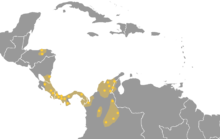
Boyacá is one of the thirty-two departments of Colombia, and the remnant of Boyacá State, one of the original nine states of the "United States of Colombia".

The Caño Limón – Coveñas pipeline is a crude oil pipeline in Colombia from the Caño Limón oilfield in the municipalities of Arauca and Arauquita in Arauca Department on the border of Venezuela to Coveñas on Colombia's Caribbean coastline. It is jointly owned by the state oil firm Ecopetrol, and U.S. company Occidental Petroleum. The pipeline is 780 kilometres (480 mi) long.

Santander is a department of Colombia. Santander inherited the name of one of the nine original states of the United States of Colombia. It is located in the central northern part of the country, borders the Magdalena River to the east, Boyacá to the south and southeast, the Norte de Santander Department to the northeast, the Cesar Department to the north, and the Bolivar and Antioquia Departments to the west. Its capital is the city of Bucaramanga.

Colombia is a unitary republic made up of thirty-two departments and a Capital District. Each department has a governor (gobernador) and an Assembly, elected by popular vote for a four-year period. The governor cannot be re-elected in consecutive periods. Departments are country subdivisions and are granted a certain degree of autonomy.

Arauca Department is a department of Eastern Colombia located in the extreme north of the Orinoco Basin of Colombia, bordering Venezuela. The southern boundary of Arauca is formed by the Casanare and Meta Rivers, separating Arauca from the departments of Casanare and Vichada. To the west, Arauca borders the department of Boyacá. The Caño Limón oil fields located within Arauca account for almost a third of the Colombian oil output. Its capital is the town of Arauca.

Arauca is a municipality and capital city of the Arauca Department of Colombia. Its full name is Villa de Santa Bárbara de Arauca, it is located at N 07° 05′ 25″ - W 70° 45′ 42″. The Municipality of Arauca has a total population of 85,585.

Occidental Petroleum Corporation is an American company engaged in hydrocarbon exploration in the United States, the Middle East, and Colombia as well as petrochemical manufacturing in the United States, Canada, and Chile. It is organized in Delaware and headquartered in Houston. The company is ranked 167th on the Fortune 500 and 669th on the Forbes Global 2000.

The Llanos is a vast tropical grassland plain situated to the east of the Andes in Colombia and Venezuela, in northwestern South America. It is an ecoregion of the tropical and subtropical grasslands, savannas, and shrublands biome.

The Guane were a South American people that lived mainly in the area of Santander and north of Boyacá, both departments of present-day central-Colombia. They were farmers cultivating cotton, pineapple and other crops, and skilled artisans working in cotton textiles. The Guane lived north of the Chicamocha River, around the Chicamocha Canyon in an area stretching from Vélez in the south to the capital of Santander; Bucaramanga in the north. Other sources state their territory did not extend so far north. Guane, a corregimiento of Barichara, Santander, is said to have been the capital of the Guane people.

The Meta River is a major left tributary of the Orinoco River in eastern Colombia and southern Venezuela, South America. The Meta originates in the Eastern Ranges of the Andes and flows through the Meta Department, Colombia as the confluence of the Humea, Guatiquía and Guayuriba rivers. It flows east-northeastward across the Llanos Orientales of Colombia following the direction of the Meta Fault. The Meta forms the northern boundary of Vichada Department, first with Casanare Department, then with Arauca Department, and finally with Venezuela, down to Puerto Carreño where it flows into the Orinoco.

Pisba is a town and municipality in Boyacá Department, Colombia, part of the subregion of La Libertad Province. Pisba is situated in the Eastern Ranges of the Colombian Andes at altitudes between 2,400 metres (7,900 ft) and 3,500 metres (11,500 ft). Distance to Sogamoso is 128 kilometres (80 mi) and to Tunja 176 kilometres (109 mi). The municipality borders Paya in the east, Labranzagrande in the south and Mongua in the northwest. The Casanare municipality Támara borders Pisba in the north.

The Lache were an indigenous, agrarian people in the highlands of what is now central Colombia's northern Boyacá and Santander departments, primarily in Gutiérrez Province and García Rovira Province. They were part of the Cocuy Confederation and spoke Chibcha, trading predominantly with other Chibcha speakers, such as the Muisca, Guane, Pijao and Chitarero. Trade included salt and textiles, as well as food stuffs. The Lache farmed maize, potatoes, quinoa and cotton, among other crops.

Tame is a town and municipality in the Arauca Department, Colombia. The municipality has a total area of around 1,060 square kilometres or 410 square miles.

Ecopetrol, formerly known as Empresa Colombiana de Petróleos S.A., not to be confused with the US owned and operated Colombian Petroleum Co. (COLPET) and sister company South American Gulf Oil Co. (SAGOC), dating to the 1930s and taken over by the state owned Ecopetrol in the 1970s, is the largest and primary petroleum company in Colombia. As a result of its continuous growth, Ecopetrol forms part of the Fortune Global 500 and was ranked 346. In the 2020 Forbes Global 2000, Ecopetrol was ranked as the 313th -largest public company in the world. It was ranked 303 in 2012 by CNN Money. The company belongs to the group of 25 largest petroleum companies in the world, and it is one of the four principal petroleum companies in Latin America.
The Uwa language, Uw Cuwa, commonly known as Tunebo, is a Chibchan language spoken by between 1,800 and 3,600 of the Uwa people of Colombia, out of a total population of about 7,000.

The Guahibo people are an indigenous people native to the Llanos or savanna plains in eastern Colombia and in southern Venezuela near the Colombian border. Their population was estimated at 23,772 people in 1998.

The Llanero Spanish is the set of linguistic modalities of the Spanish language spoken in the Venezuelan-Colombian Llanos region. It is characterized by the mixing of elements from Old Spanish with indigenous elements.

The Tegua or Tecua were an Arawak-speaking indigenous people of Colombia who died out in the 19th century.

The Llanos Basin or Eastern Llanos Basin is a major sedimentary basin of 96,000 square kilometres (37,000 sq mi) in northeastern Colombia. The onshore foreland on Mesozoic rift basin covers the departments of Arauca, Casanare and Meta and parts of eastern Boyacá and Cundinamarca, western Guainía, northern Guaviare and southeasternmost Norte de Santander. The northern boundary is formed by the border with Venezuela, where the basin grades into the Barinas-Apure Basin.


























